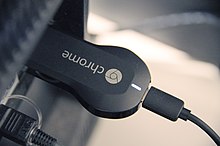Dongle

A dongle is a small piece of hardware that attaches to a computer, TV, or other electronic device in order to enable additional functions such as copy protection, audio, video, games, data, or other services. These services are available only when the dongle is attached.
Although the term "dongle" was originally used to refer only to software protection devices, it is now more broadly applied.
Examples of dongles
Copy protection
- The 10NES chip on the Nintendo Entertainment System only allows the machine to boot up if a game with the appropriate proprietary licensed key chip is inserted.
- The CD-based parts catalog (known as "ETKA") used by Volkswagen Group used since 1989 requires a coded dongle be plugged into a host computer's port in order to run.
Copy protection circumvention
- Some unlicensed game cartridges have a "daisy chain" that allows licensed games to pass along their authorization, for instance to circumvent the 10NES chip on the Nintendo system mentioned above.
Actual devices

- Small devices that plug into other equipment to add functionality are often referred to as dongles; for example the infrared remote control adapters available for "smart" mobile phones, or internet content streaming devices such as the Chromecast or Roku Stick.
Adapters
- Very short cables that connect relatively large jacks to smaller plugs allowing cables to be easily installed and removed from equipment with limited space available for connectors. The Chromecast device mentioned above, for example, comes with a short HDMI extension cable to allow its use in cramped quarters.
Other
- Cassette adapters enable cassette-radios to allow AUX in, like with iPod/MP3 player/smartphone (portable CD players before 2000)
- Personal FM transmitters allow content from a portable media player, portable CD player, smartphone, portable cassette player, or other portable audio system to be heard on an FM radio.
- IDE/PATA connectivity can be re-channeled with some dongles:
- Floppy disk drives have been emulated on solid-state "dongles" to ensure legacy recognition, allowing SD cards to serve software to old Commodore 64 and Apple II era computers.
- Allows SD cards to be recognized as "hard drives" on old DOS computers
- Old school video game consoles:
- The Everdrive series of game cartridges has enabled classic systems such as the Sega Megadrive and Nintendo 64 to allow one cartridge to have a number of games that were formerly on multiple cartridges of their own, by use of an SD card with ROMs on them; since it can allow a real game console to access ROMs, which an emulator would normally do.
- The Sega 32X was an add-on for the Sega Megadrive which allowed a 32-bit library of games to play on a system that was normally just 16-bit, though it suffered from having its own video output, and its own AD adapter in order to work.
- USB host connectivity grants more flexibility to computer-based devices
- bluetooth
- legacy game controllers have special adapters
- SD card readers
- thumbdrives
- MHL. A dongle enables adaptation to legacy standards such as HDMI via conversion circuitry contained in the dongle itself. MHL dongles often allow USB connections and/or device charging as well.
- Older cars that "externalized" their CD players and changers from the head unit can now use "emulators" that allow USB and SD cards with MP3s and other audio files to be recognized as "tracks" to the CD control unit circuitry.
See also
